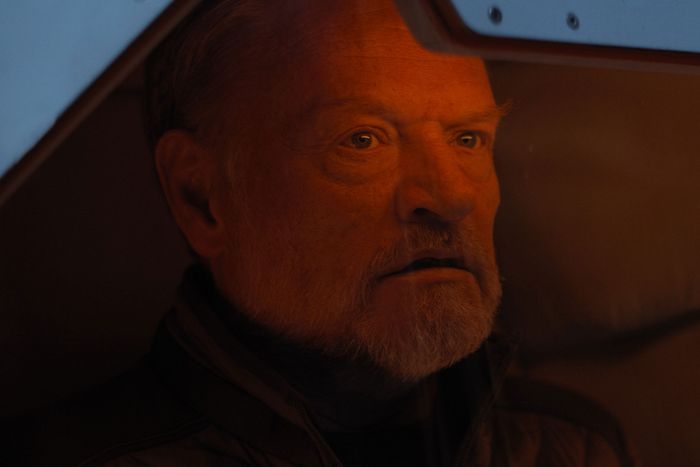
Spoilers ahead for “Creation Myths,” the season-two finale of Foundation.
Season two of Foundation has been a clear improvement from season one. There’s more steady connective tissue between its many timelines and far-flung stories, and it’s gotten better at building smaller emotional arcs that help ground each episode. The show needed to move further from Asimov’s original texts and become even more TV-like, which makes complete sense as the best approach for an adaptation of an infamously unfilmable story. Characters have to stick around longer and have more intense and long-lasting relationships with one another. Gaal Dornick, after being frozen in time, gets to have a whole relationship with her daughter, Salvor Hardin, and they both know it’s weird and poignant. Hari Seldon, the man who kicked off the entire Foundation crisis, can remain in the story to watch how it all plays out and put his thumb on the scale of destiny. Even in season one, the central concept of Foundation’s TV adaptation was to create a device that would allow Lee Pace to remain on the show forever, and that’s just smart writing.
But season two has also come right up to the far edge of how long characters can hang around in a story without breaking the stakes. It’s one thing to create more long-arc figures whose feelings and motivations can help glue together a big story about the centuries-long collapse of civilization. It’s another thing when the story insists that none of those central characters ever be allowed to die, thereby preventing the biggest, most serious conflicts from ever feeling quite big or serious enough.
Gaal Dornick was jettisoned into space in a cryofreeze containment system, rescued, allowed to play out a whole fascinating reunion story with her daughter, and is now entering cryofreeze yet again so she can influence a later stage of the second Foundation. An enormous cataclysm destroys the planet Terminus, killing everyone including Bel Riose’s husband — except not! Because they’re all rescued by the Vault, which also rescues Brother Constant, who’d been sent hurtling out into space. Most egregiously, there’s Hari Seldon, who had already died and been revived at the beginning of season two, only for it to happen again later in the season by way of psychic possession that allowed him to somehow punch his way out of a water jail.
A few characters do appear to have actually died by the end of season two, including Hober Mallow, Bel Riose, and most significantly, Salvor Hardin. They’re distressing deaths, especially Salvor’s, and her sacrifice to save Gaal becomes an important motivation for what will come in season three. Except once it becomes possible for the ghost of Hari Seldon to walk into a giant rock shaped like a head and come out with a new body, or for that body to then die by drowning and then somehow still be alive through … punching (?) … it’s hard to trust that Salvor’s really gone. Everyone from Terminus survived in the Vault, after all! Maybe somehow the Vault kept a psychic record of Salvor, too, and she can find her own rock formation that looks like a head and get back to doing humanity-saving stuff. A piece of the Mentalic witch lady was saved inside the brain of a little boy. Maybe Salvor’s in someone else’s brain! You never know!
Obviously, either of those resurrection scenarios would be explicitly silly, which Foundation only rarely deigns to be. That doesn’t change the fact that this is now a show with a pretty healthy record of resurrection scenarios. It’s hard to really accept the need to mourn for Salvor Hardin, even though Gaal seems sure she’s gone.
In the broader sense, diminishing the potency of death in Foundation also diminishes some of the show’s central thematic weight. Its primary preoccupation is with the interlocking but distant connections between individual actions and enormous, universe-size shifts, and one of the key tragedies at its core is that although some individuals can be absolutely crucial, in many other cases they simply do not matter all that much. Sometimes the show is adept at playing with that idea. Season two’s climactic scene where Emperor Day is shoved out the airlock plays into precisely that tension of immortality and continuation versus individual personhood: We all know another Emperor Day will show up immediately, looking and sounding and ruling almost exactly the way the previous one did. Day’s entire arc this season, though, is meant to put pressure on the difference between this particular guy and the other men in his genetic cohort. His existence is both a canny character device and fascinating thought experiment: How much of personhood is distinct from genetic makeup? How much deviation can there be between these identical copies? But the counterexample is Hari Seldon, whose multiple deaths and resurrections (and now cryofrozen future) only get muddier. How much does he change between resurrections? What exactly are his motivations now? Is he a person, or a god, or a convenient story device with a penchant for mansplaining?
This may end up being a season-two problem, and season three will have a better handle on how to balance continuing characters with meaningful stakes. Foundation’s improvement from season one to season two is plenty of reason to hope that the show will continue to trend in the right direction. The fix is relatively simple, after all: Let the dead stay dead, and if they must come back, find more sensible ways to do it than having them psychic their way out of a drowning.


